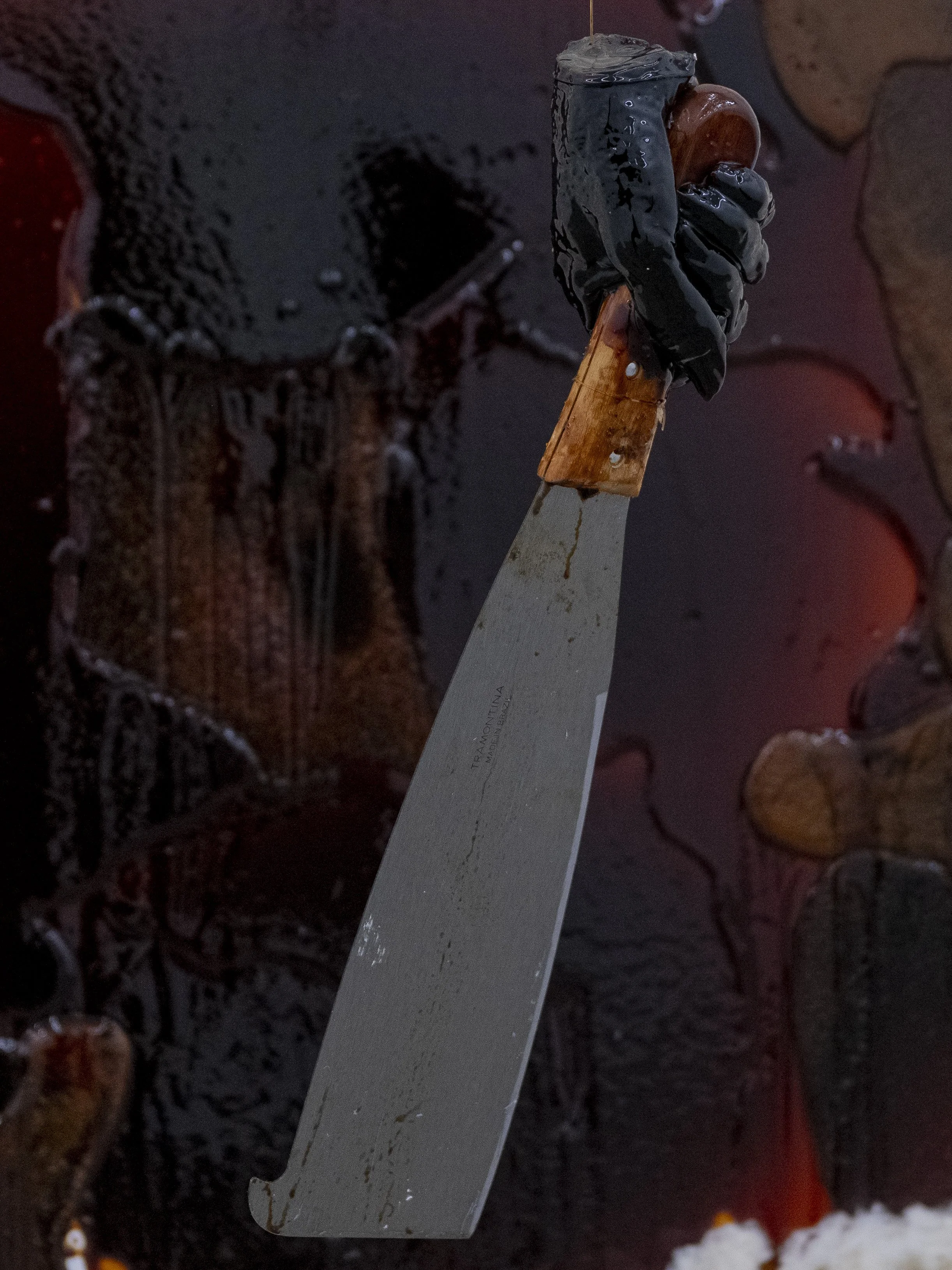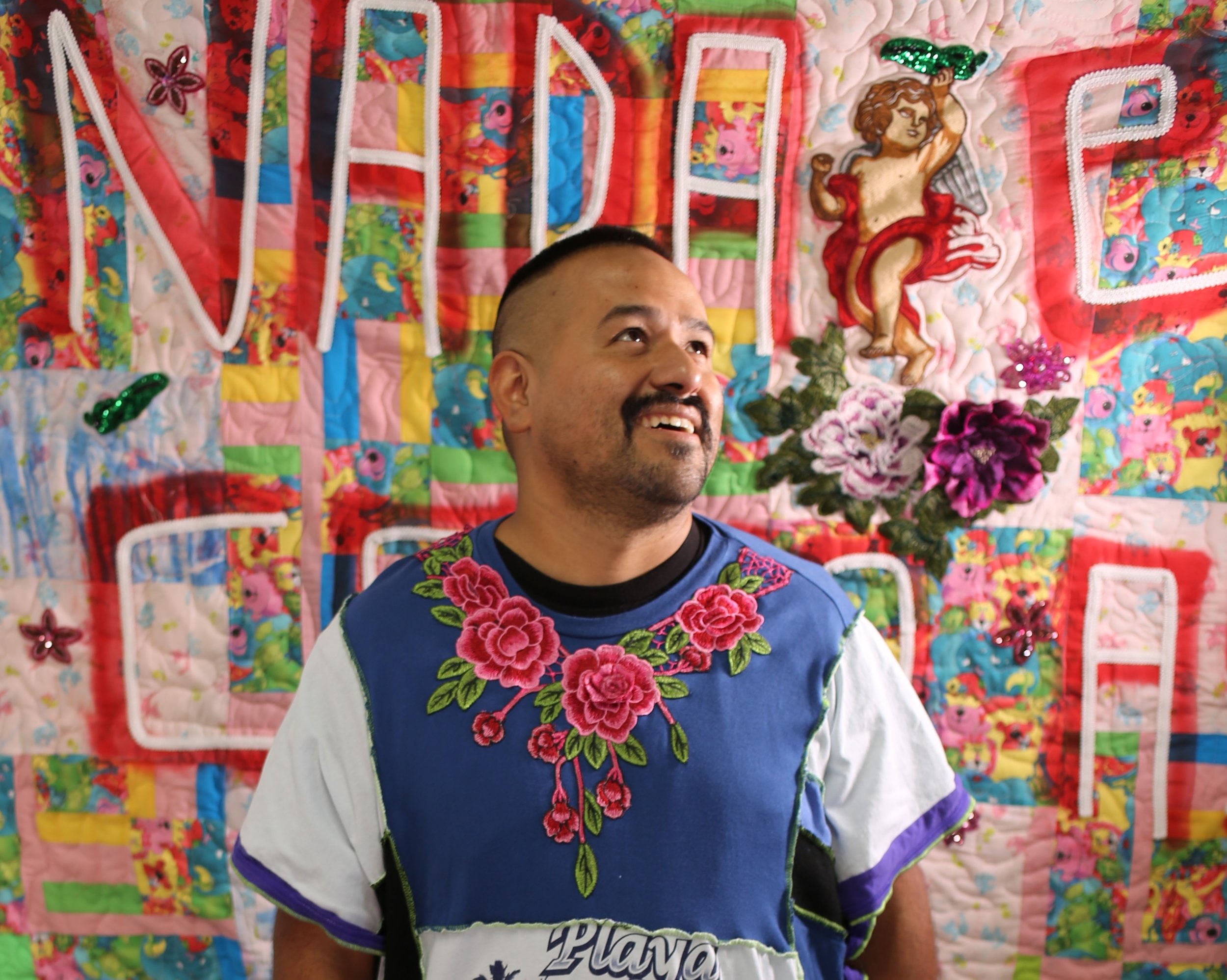Art
Rituals
Performances
Parade
Art Rituals Performances Parade
August 23, 2025
4:00PM - 9:00PM
SF Chinatown
八月 23, 2025
4:00PM - 9:00PM
舊金山華埠
Artist Statements 藝術家自述
-
The Apparition is a sculptural live art installation offering collective healing through communal ritual and sacred ceremony. Capitalism and greed are the true Demons of Our Time, impacting BIPOC and LGBTQ communities. Our legends and myths are stolen from marginalized peoples as quickly as our land rights—today echoed in the policing of art, history, culture, and research.
I use the body as a vessel for ancestral rebirth, reclaiming Indigenous myths from Western constructs of God and religion. Drawing from Indigenous and Afro-diasporic traditions, the red sap of “bloodroot” symbolizes protection, vitality, bloodlines, and ritual purification. Audience members are asked to leave white flowers as offering to appease these spirits as the sculpture destroys itself, consuming them.
As a descendant of the Mississippi Band of Choctaw Indians and enslaved Africans who survived the Middle Passage, I call in wayward ancestors—spirits burdened by inherited trauma and racial injustice—to release them, forging space for a brighter future.
The work incorporates sugar, an ode to impermanence and a reminder of its violent legacy on Indigenous lands and communities. When it melts, only thoughts remain, inviting the audience to confront death, value, ownership, and their own ancestral healing in the present realm.
《The Apparition》是一件雕塑性現場藝術裝置,透過集體儀式與神聖祭儀提供共同療癒。資本主義與貪婪才是這個時代真正的惡魔,持續侵害著BIPOC(黑人,原住民及有色人種)與LGBTQ社群。我們的傳說與神話正如土地權般被快速從邊緣群體掠奪——如今這現象更體現在對藝術、歷史、文化與研究的管控中。
我以身體作為容器實現祖靈重生,從西方建構的上帝與宗教觀念中奪回原住民族的神話。汲取原住民與非洲流散傳統的養分,「血根草」的紅色汁液象徵著保護、生命力血脈與儀式淨化。邀請觀眾獻上白花作為祭品,安撫那些在雕塑自我毀滅過程中被吞噬的靈體。
作為密西西比喬克托印第安部落與經歷中途航線倖存的非洲奴隸後裔,我召喚那些背負世代創傷與種族不公的迷途先祖靈體,釋放他們,從而為更光明的未來開創空間。
作品融入糖這種材料,既是對無常的禮讚,也是對其在原民土地與社群造成暴力遺產的警示。當糖融化殆盡,唯留思緒長存,引領觀眾直面死亡,價值,所有權,以及自身在當下領域中的祖傳療癒課題。
-
A Ritual in Process is an art installation featuring a coven of figurative soft sculptures depicting witches, or brujas. Each bruja is uniquely crafted with a patchwork huipil made from reclaimed T-shirts, blending Oaxacan heritage with American punk influences, and adorned with acrylic nails that subtly celebrate queer and drag aesthetics.
Arranged in a circular formation, viewers are invited to step into a space of unexpected magic, as if stumbling upon a hidden, sacred ceremony. This creates a dynamic visual experience, evoking an ethereal, spirit-like presence. The coven itself, a symbol of communal strength and shared ritual, provides a visual sanctuary for reflection, protest, and transformation.
This installation reclaims the figure of the witch as a powerful symbol of resilience for marginalized communities—including immigrants, queer individuals, and BIPOC voices. It challenges conventional notions of who the "demon" truly is, transforming negative perceptions into sources of strength and self-acceptance. Ultimately, "A Ritual in Process" aims to create a living gateway for healing and empowerment, fostering connection and celebrating multifaceted identities across San Francisco's diverse communities.
《A Ritual in Process》是一件藝術裝置,呈現了一群象徵一群女巫(brujas)的具象軟雕塑集會。每位bruja皆獨一無二,身著以回收T恤拼縫而成的huipil傳統繡花上衣,這種設計融合了瓦哈卡傳統與美國龐克風格的影響,並點綴著彰顯酷兒與變裝美學的壓克力指甲。
她們以圓陣形式排列,邀請觀者踏入一個充滿意想不到魔力的空間,宛如偶然撞見一場隱秘的神聖儀式。這創造出一種極具動態的視覺體驗,喚起一種空靈如神靈親臨般的氛圍。這個女巫集會本身作為集體力量與共享儀式的象徵,為沉思抗爭與蜕變提供了一個視覺上的庇護所。
本裝置藝術將女巫形象重新定義,成為邊緣群體,包括移民、酷兒與BIPOC黑人、原住民及有色人種,堅韌力量的有力象徵。它挑戰了社會對於誰才是真正惡魔的固有觀念,將負面標籤轉化為力量與自我接納的源泉。最終,《A Ritual in Process》旨在開創一個療癒與賦能的活通道,促進連結,並頌揚舊金山多元社群中各種複雜交織的身份認同。
-
Alu ki he ‘Otua is a ritual altar grounded in Tongan mourning practices and spiritual symbolism. The altar acts as both portal and protest—inviting visitors to sit with their grief, honor their ancestors, and release the burdens they carry. Through cultural aesthetics, collective memory, and guided ceremony, this space transforms Chinatown into a shared site of cross-cultural healing.
In response to the festival’s theme, Demons of Our Times, this altar names the silent grief and systemic erasure of Pasifika people in diaspora. The demons confronted include colonization, cultural invisibility, and the quiet criminalization of brown youth. The altar is sacred ground for those unseen and unheard—to mourn, to honor, and to be remembered.
《Alu ki he ‘Otua》是一座根植於東加哀悼傳統與精神象徵的儀式祭壇。這座祭壇既是通道也是抗爭——邀請訪客安駐於哀傷之中,敬奉先祖,並釋放他們肩負的重擔。透過文化美學,集體記憶與引導式儀式,此空間將華埠轉化為跨文化療癒的共享場域。
回應本屆藝術節「破魅而生」的主題,此祭壇直指太平洋島民在流散過程中承受的沉默悲傷與系統性抹除。其所直面之惡魔,包括殖民侵略、文化隱形,以及棕色青年被無聲定罪的社會現實。這座祭壇是為那些不被看見亦不被聽見之人所設的神聖境地——在此哀悼,在此致敬,在此被銘記。
-
In the original story Mulain offers food and drink to the Gods in order to release his mother from hell and succeeds.
My mobile altar is made of a steel cart, black curtains, lanterns, and incense burners. It will have 2 or 3 female ghosts appearing out of the cart at certain times during the procession. The female ghost mask will be upholstered into the long fabric and will rise 9 to 10 feet into the air, with the help of actors. The actors will be seated in the cart to raise the fabric and wood mask ghost.
This altar is dedicated to the women in wars, whose lives are shattered by bomb raids and drone attacks, with no regards to civilians. The mothers always suffer the most: from the death of their children and themselves trying to protect them from harm. The rising death toll with modern war tactics in Ukraine and Palestine is never ending.
在原故事中,Mulain通過向神靈獻祭飲食,最終成功將母親從地獄解救。
我的移動祭壇由鋼製推車、黑色布幔、燈籠與香爐構成。在行進過程中,將有兩至三名女性幽靈不定時自推車中顯現。這些以織物與木質面具製成的女鬼形象將由藏身推車內的表演者操控,伴隨長幅布幔升至九至十英尺高空。
此祭壇獻給所有戰爭中的女性——她們的生命在轟炸與無人機攻擊中支離破碎,而平民身份從未獲得絲毫顧惜。母親總是承受最深的苦難:既要面對子女的死亡,又得在護佑孩子時自身罹難。隨著現代戰爭戰術在烏克蘭與巴勒斯坦的運用,持續攀升的死亡數字從未止息。
-
Alchemizing Addiction confronts one of the greatest demons of our time—addiction. Two years ago, I lost my father, who struggled with methamphetamine and crack cocaine addiction for most of my life. He was my best friend. Through grief, I modify objects tied to our deepest pain into a source of beauty and healing.
I am an alchemist who creates mixed media artworks and installations to transform emotional trauma. As a practitioner of Ifá, an African spiritual tradition, I use my artistic practice as a means of communing with and honoring my ancestors. By tackling issues such as systemic racism, addiction, and mass incarceration, my art speaks truth to power while opening a pathway to healing for those engaging with my creations.
For the Hungry Ghost Festival, I expand on the altar I created for my father by crafting four chandeliers to honor those in the Bay Area who we have lost to various forms of addiction to drugs and alcohol.
The altar is a living portal to honor loved ones that we have lost to addiction – holding candles, glasses of water, flowers, food, and space for visitors to add their loved ones' names to the table in real time.
《Alchemizing Addiction》直面當代最猙獰的惡魔——成癮症。兩年前,我失去了與甲基安非他命和古柯鹼搏鬥大半生的父親。他是我最好的朋友。在悲慟中,我將縈繞著最深切痛苦的物件轉化為美與療癒的源泉。
身為煉金術士,我創作混合媒材藝術與裝置作品來轉化情感創傷。作為非洲伊費信仰的修行者,我將藝術實踐作為與先祖對話致敬的儀式。透過直面體制性歧視,成癮問題與大規模監禁等議題,我的藝術既向權力訴說真相,也為觀者開闢療癒之路。
因應華埠鬼節,我以四盞枝形吊燈擴充原本為父親創作的祭壇,紀念灣區因各種藥物與酒精成癮而逝的生命。
這座祭壇是通往緬懷之境的活通道——我們在此為被成癮症奪走的至親點燃蠟燭、供奉清水鮮花與食物,並提供空間讓訪客即時將摯愛姓名添至祭台。
-
Anito ng Naglakbay is a site-specific altar and ritual installation honoring diasporic ancestors, migrants, wandering spirits, and the demonization of diasporic Indigenous healing and spiritual practices. It draws from Philippine ancestral traditions, oral histories of migration, and ritual gestures for cleansing and protection, especially for those experiencing persecution and family separation under this administration’s immigration policies. The altar is a living portal, activated by movement, scent, and sound—calling in the wisdom of those displaced and dismissed, while clearing the path for healing and belonging.
《Anito ng Naglakbay》是一座特定場域祭壇與儀式裝置,敬奉流散先祖,遷徙者,遊蕩之靈,以及那些被妖魔化的流散原民療癒與精神實踐。作品汲取菲律賓先祖傳統,遷徙口述歷史,以及淨化庇護的儀式姿態,特別獻給在此政權移民政策下遭受迫害與家族分離之人。這座祭壇是處由動作、氣味與聲響激活的活態通道,召喚那些被流放與輕蔑之魂的智慧,同時為療癒與歸屬清整道路。
Artist Activations 藝術活動
Aambr Newsome
Aambr Newsome is an interdisciplinary artist whose practice spans performance, public art, installation, and printmaking, with a central focus on materiality as a gateway to ancestral memory. They investigate the histories embedded in materials tied to the transatlantic slave trade—sugar, cotton, and other crops cultivated through forced labor—exploring their cultural, spiritual, and historical resonance. Their process unfolds in connecting with their higher self, becoming a vessel for the messages embedded within these substances. Through sculpture, performance, and site-specific installations, they interrogate labor, exploitation, and the body’s relationship to material goods that once defined entire economies and continue to shape our collective memory. This material exploration is a spiritual practice as much as it is a creative one. They blend African and Indigenous traditions with Afrofuturist narratives, forging connections between the past and the future. These works seek to reclaim the legacies stolen through oppression, offering new ways to understand identity, spirituality, and ritual. By working with the very materials that sustained oppressive systems, they aim to shift narratives of race, gender, and value toward liberation and transformation.
Aambr Newsome是一位跨領域藝術家,其創作橫跨行為藝術、公共藝術、裝置與版畫,核心關懷是以物質性作為通往祖靈記憶的通道。他們探究那些與跨大西洋奴隸貿易緊密相連的物質:糖,棉花及其他透過強迫勞動耕作的作物,挖掘其中蘊藏的文化,精神與歷史共鳴。其創作過程始於與更高自我的對話,成為承載這些物質內在訊息的容器。透過雕塑,行為與特定場域裝置,他們叩問勞動,剝削,以及人體與那些曾定義整個經濟體系,至今仍塑造集體記憶的物質商品之間的關係。這種物質探索既是創作實踐,亦是靈性修持。他們融合非洲與原住民傳統及非洲未來主義敘事,鑄造過去與未來之間的連結。這些作品企圖奪回被壓迫體制竊取的遺產,提供理解身份,靈性與儀式的新途徑。透過運用那些曾支撐壓迫體系的物質材料,他們試圖將關於種族,性別與價值的敘事,導向解放與轉化。
Reyna Brown
Reyna Brown is a Queer, Black, Chicana mother, artist, and alchemist who uses mixed media and installation to transform emotional trauma and honor ancestral memory. A practitioner of Lucumí, an Indigenous African spiritual tradition, Reyna approaches art as a sacred practice—channeling spirit to confront systemic racism, addiction, and mass incarceration while creating space for healing. Her multidisciplinary work spans painting, ceramics, glass blowing, beading, embroidery, and immersive altar installations. Raised among the strawberry fields of Oxnard, California, she draws strength from her cultural lineage and deep commitment to community. Reyna earned a B.A. in Performing Arts and Social Justice from the University of San Francisco, with a concentration in Theater and a minor in Peace and Justice Studies. She is currently pursuing an MFA in Interdisciplinary Arts at the California Institute of Integral Studies. She serves as lead facilitator of the Artistic Ensemble, a performance collective inside San Quentin State Prison. She teaches Performing Arts and Community Exchange at USF, connecting students with incarcerated artists. Through altar work and spirit-led creation, Reyna reclaims grief as a portal—inviting personal and collective liberation.
Reyna Brown是一位酷兒,非裔與墨西哥裔混血的母親,藝術家與煉金術士。她運用混合媒材與裝置藝術轉化情感創傷,並敬奉祖靈記憶。作為非洲原住民靈性傳統「盧庫米」(Lucumí)的修行者,芮娜將藝術視為神聖實踐—透過靈性引導直面體制性歧視,成癮問題與大規模監禁,同時開創療癒空間。其跨領域創作橫跨繪畫,陶藝,吹玻璃,珠繡,刺繡及沉浸式祭壇裝置。成長於加州奧克斯納德的草莓田間,她從文化血脈與對社群的深刻承諾中汲取力量。
芮娜於舊金山大學取得表演藝術與社會正義學士學位,主修戲劇並輔修和平與正義研究,現於加州整合研究學院攻讀跨領域藝術碩士。她擔任聖昆汀州立監獄內部表演團體「藝術合奏團」的首席導師,並在舊金山大學教授表演藝術與社群交流課程,連結學生與受監禁的藝術家。透過祭壇創作與靈性引導的藝術實踐,芮娜將悲慟重新鑄造為通往個人與集體解放的通道。
Alexander Hernandez
Based in San Francisco, artist Alexander Hernandez was born in Huajuapan de Leon Oaxaca, Mexico, and raised in Grand Junction, Colorado. His mixed-media practice, concentrating in textiles, explores the intersectional identities of immigrant experience, queer sensibilities, gender expectations, and HIV+ survival. He earned his BFA from Rocky Mountain College of Art & Design (2007) and his MFA from California College of the Arts (2012). He has participated in significant residencies, including Mass MoCA, Mark Rothko Art Center, and Vermont Studio Center. Currently, Alexander also works at Creativity Explored in San Francisco, assisting neurodiverse artists and those with disabilities in their art creation.
駐舊金山藝術家Alexander Hernandez出生於墨西哥瓦哈卡州的華華潘德萊昂,在科羅拉多州大章克申市成長。其混合媒材創作以紡織品為核心,探索移民經歷,酷兒感知,性別期待與愛滋病毒帶原生存者等交織性身份議題。他於落磯山藝術設計學院取得藝術學士學位(2007年),並於加州藝術學院獲得藝術碩士學位(2012年)。曾參與多個重要藝術駐村項目,包括麻州當代藝術博物館、馬克·羅斯科藝術中心與佛蒙特工作室中心。現亦任職於舊金山「創意探索」機構,協助神經多樣性藝術家與身心障礙者進行藝術創作。
John Aragon
John Aragon is a multidisciplinary artist whose work reflects decades of experience as a craftsman, welder, designer, and visual merchandiser. His practice spans an eclectic mix of mediums—ranging from faux finishes and fabric work to the refined stains and finishes of high-end cabinetry, as well as intricate treatments in steel. A defining feature of Aragon’s art is the integration of simple kinetic elements. Using small motors to animate select components, his work invites viewers into an engaging and often unexpected visual dialogue. Many of his pieces are infused with thematic or political commentary and thoughtfully combine found objects with precision-crafted elements. The result is a body of work that is both conceptually layered and viscerally captivating.
John Aragon是一位多領域藝術家,其作品反映了數十年來作為工匠,焊工,設計師與視覺陳列師的深厚經驗。他的創作橫跨多元媒介範疇,從仿飾面處理與織物創作,到高端櫥櫃的精緻染色與塗裝,乃至鋼材的複雜工藝處理。Aragon藝術的標誌性特徵在於融合簡約的動態元素—透過小型電機驅動特定部件,使作品引導觀者進入一場引人入勝且充滿驚喜的視覺對話。其多數作品蘊含主題性與政治性評論,並巧妙地將現成物與精密製作的元件相結合,最終形成既具層次概念又直擊感官的藝術成果。
Kimberely Acebo Arteche
Kimberley Acebo Arteche is a multidisciplinary artist, healing justice practitioner, and cultural worker committed to reindigenizing cultural practices and fostering community-based art. Their work explores diasporic remembering and belonging through installation, photography, and community ceremonies. Arteche’s practice is deeply rooted in ritual, research, and ancestral knowledge, engaging communities in collective acts of remembrance and cultural reclamation.
Kimberley Acebo Arteche是一位跨領域藝術家、療癒正義實踐者及文化工作者,致力於文化實踐的再原民化與社區藝術的培育。其作品透過裝置、攝影與社群儀式,探索流散族群的記憶與歸屬議題。Arteche的創作深植於儀式、研究與祖靈知識,引領社群參與集體記憶行動與文化復振實踐。
Tracy Williams
Tracy Williams is a Tongan American muralist, cultural educator, and community art healer based in Oakland, Ca. She is the founding art teacher at The Freedom School and co-director of “Dreams Arts & Activism,” an award-winning afterschool program centering youth power, ancestral creativity, and collective healing. She leads trauma-informed art sessions with One East Palo Alto organization and youth in custody in Utah, with partnerships including the Utah Division of Multicultural Affairs, Utah Division of Arts and Museums and Juvenile Justice Youth Service. Her work weaves Pasifika spirituality, cultural grief work, and public storytelling into transformative community spaces. Her visual practice merges public installations, murals, and rituals that honor the sacred labor of Indigenous and diasporic women. She uses restorative art to amplify invisible histories, empower youth, foster intergenerational healing, and create visual altars that merge culture, protest, and prayer.
Tracy Williams是一位東加裔美國壁畫家、文化教育者及社群藝術療癒師,現居加州奧克蘭。她創辦自由學校並擔任首任藝術教師,同時共同指導以青年力量,祖靈創造力與集體療癒為核心的得獎課後計畫「夢想藝術與行動主義」。她為東帕羅奧圖組織與猶他州受監護青少年創辦創傷知情藝術課程,合作單位包括猶他州多元文化事務處。猶他州藝術與博物館局及青少年司法服務處。其作品將太平洋島民靈性,文化哀悼工作與公共敘事交織成具轉化力的社群空間。她的視覺實踐融合公共裝置,壁畫與儀式,致敬原住民與流散女性的神聖勞動。透過修復式藝術,她放大被隱沒的歷史,賦權青年,促進跨世代療癒,並創造融合文化,抗爭與祈禱的視覺祭壇。









